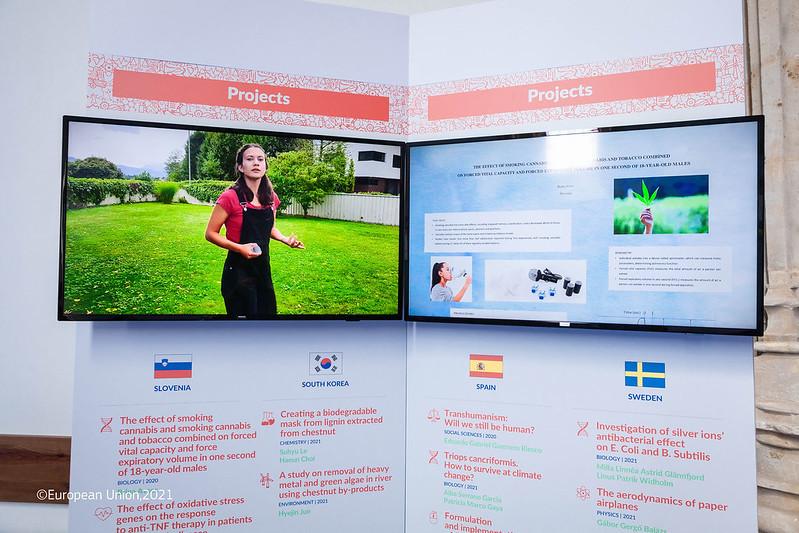Last week the first-ever hybrid European Union Contest for Young Scientists (EUCYS) rewarded and celebrated the best young scientific talent that Europe has to offer
By Jerry Stamatelos
The 32nd edition of the EUCYS Awards Ceremony was unlike any of its predecessors. Combining both 2020 and 2021 because of COVID-19, this hybrid event gathered 158 of the brightest young minds between the ages of 14 and 20 from 34 countries in Europe and abroad. A virtual space was created for the students to get to know each other and discuss their projects.
Competing either individually or as teams, the contestants presented their projects in any scientific field completely online to a panel of 25 international judges. The most represented categories were computing (16%), engineering (15%), biology (13%), physics (13%) and the environment (11%).
In total, 50 contestants with 41 projects (2020) and 108 contestants with 73 projects (2021) competed for 18 first, second and third place prizes. This year, 21 European Union (EU) Member States participated as well as Belarus, Canada, China, Egypt, Georgia, Israel, Norway, Russia, South Korea, Switzerland, Turkey and Ukraine.
For 2020, the first prizes were awarded to Cormac Thomas Harris and Alan Thomas O’Sullivan (Ireland) for “A statistical investigation into the prevalence of gender stereotyping in 5-7 year olds and the development of an initiative to combat gender bias”; and Feridun Balaban (Turkey) for “Investigation of spectral response and efficiency of boron and nitrogen doped diamond-like carbon as a top junction on multijunction solar cells”.
For 2021, the first prizes were awarded to Viktor Stilianov Kolev (Bulgaria) for “Neural Abstract Reasoner”; Marik Müller (Germany) for “Enzymatic inactivation of the veterinary antibiotic florfenicol”; Carla Caro Villanova (Spain) for “Formulation and implementation of a support vector machine on D-Wave’s quantum annealer”; and Illia Nalyvaiko (Ukraine) for “Properties of possible counterexamples to the Seymour’s Second Neighborhood Conjecture”.
The six second prizes and six third prizes were awarded to projects from Belarus, Bulgaria, Canada, Czechia, Ireland, Italy, Poland, Slovakia, Switzerland and Turkey.
First place winners receive €7,000 each. All the winners share a total of €93,000 in prize money.
In addition to the cash prizes, several contestants received an all-expenses-paid trip to London to attend the London International Youth Science Forum in the summer of 2022. Other prizes include stays at leading scientific organisations, such as the European Organization for Nuclear Research, the European Space Agency and the Joint Research Centre.
EUCYS truly highlights the top achievements of science students. All participants have previously won first prize in their home countries’ national science competitions. Projects must be nominated by the national organiser in each participating country.
Carla Caro Villanova, a 17-year-old physics student at the University of Barcelona, Spain, wants to become a researcher in quantum physics or similar field. She earned first place for the project “Formulation and implementation of a support vector machine on D-Wave’s quantum annealer”.
Carla described the project as follows: ‘It consists of executing a machine learning algorithm in a quantum computer. Machine learning is a field of computer science in which the own algorithm “learns” from data and tries to find patterns so as to model it. For example, it can be used to classify medical data and distinguish between non-cancerous and cancerous tumours, just as I did in this project.’
Carla explained what got her interested in this domain. ‘Two years ago I came across physics, specifically quantum physics, during a summer stay at the Institute of Photonic Sciences in Barcelona. It was then that I knew I wanted to do research in this field for a living. I kept on studying quantum mechanics on my own and contacted the research group Barcelona Supercomputing Center, who gave me more resources to pursue my project.’
Women in science, technology, engineering and mathematics (STEM) are underrepresented. How can we get more young women to choose STEM fields? ‘I believe young women should be encouraged to get involved in STEM from a very early age without making a distinction between them and their male counterparts,’ said Carla. ‘It is very important to give visibility to women in science and recognise their work so as to inspire and encourage them. They have the same capacity to reach their goals in research.’
Viktor Stilianov Kolev, an 18-year-old Bulgarian student at Stanford University, United States, hopes to pursue mathematics and computer science, with a focus on artificial intelligence (AI). He earned first place for the project “Neural Abstract Reasoner”.
Viktor explained the project in practical terms: ‘Current AI systems can help us identify objects on the road or translate text. However, what they lack are notions like “cause and effect”, or concepts such as “object” or “action”. For AI to be interpretable, explainable, human-centric and transparent, it needs to be as similar as possible to human thought. So we need it to learn some “core knowledge”, the ideas that make us intelligent. In my project, we combined the most novel interdisciplinary approaches, ranging from engineering feats in fast hardware computation to a variety of AI techniques, theoretic statistical analysis and approximation theory. This was done to derive a package solution for training AI that sets a new state of the art for a data set of logical puzzles, similar to an IQ test.’
Attracting more young people to science is a question of opportunity, says Viktor. ‘Science is an ultimate form of formalised curiosity, which is an all too human trait. Therefore, people, especially young people, have an intrinsic drive for science. We only need to present the opportunity for them to follow this drive.
This article was originally published in Horizon, the EU Research and Innovation magazine.







Click here to change your cookie preferences